Who Controls the User Experience? AMD’s Carrizo Thoroughly Tested
by Ian Cutress on February 4, 2016 8:00 AM ESTBenchmark Results: Web and Synthetic
Here are our results from our web and synthetic tests. A reminder of our systems:
| System Overview | |||||
| µArch | APU | Base / Turbo MHz |
Memory | Channel | |
| HP Elitebook 745 G2 | Kaveri | A10 PRO-7350B (19W) | 2100 / 3300 | 8 GB | Dual |
| HP Elitebook 745 G3 | Carrizo | PRO A12-8800B (15W) | 2100 / 3400 | 4 GB | Single |
| Toshiba Satellite E45DW-C4210 |
Carrizo | FX-8800P (15W) | 2100 / 3400 | 8 GB | Single |
| HP Pavilion 17z-g100 |
Carrizo | A10-8700P (15W) | 1800 / 3200 | 8 GB | Single |
| Lenovo Y700 | Carrizo | FX-8800P (15W) | 2100 / 3400 | 16 GB | Single |
Google Octane 2.0
Lots of factors go into web development, including the tools used and the browser those tools play in. One of the common and widely used benchmarks to judge performance is Google Octane, now in version 2.0. To quote: 'The updated Octane 2.0 benchmark includes four new tests to measure new aspects of JavaScript performance, including garbage collection / compiler latency and asm.js-style JavaScript performance.' We run the test six times and take an average of the scores.
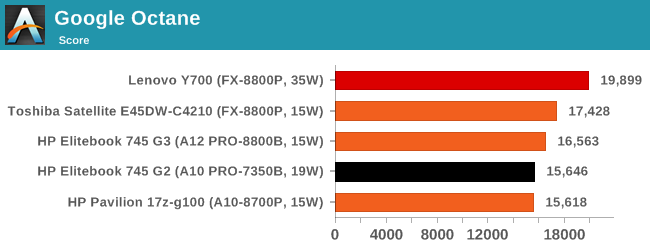
Octane splits hairs between the Kaveri and A10-8700P, but the Toshiba has the higher skin temperature and can turbo for longer than the Elitebook G3.
Mozilla Kraken 1.1
Kraken is a similar tool to Google, focusing on web tools and processing power. Kraken's tools include searching algorithms, audio processing, image filtering, flexible database parsing, and cryptographic routines.
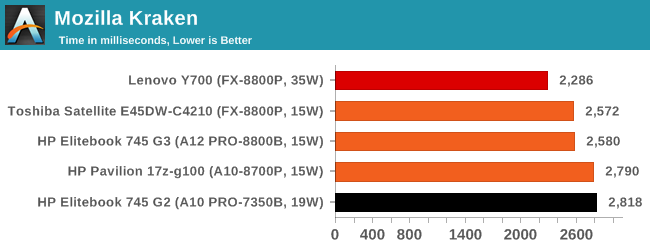
Kraken mirrors Octane, except this time the A10-8700P gets a jump on the Kaveri.
WebXPRT 2013/2015
WebXPRT aims to be a souped up version of Octane and Kraken, using these tools in real time to display data in photograph enhancement, sorting, stock options, local storage manipulation, graphical enterfaces and even filtering algorithms on scientific datasets. We run the 2013 and 2015 versions of the benchmark.
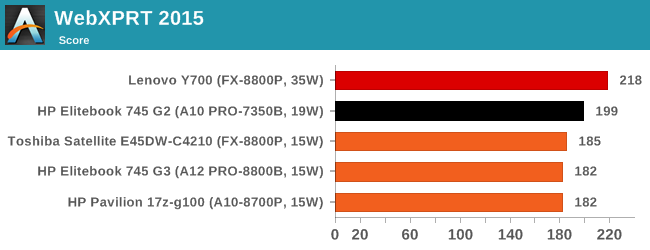
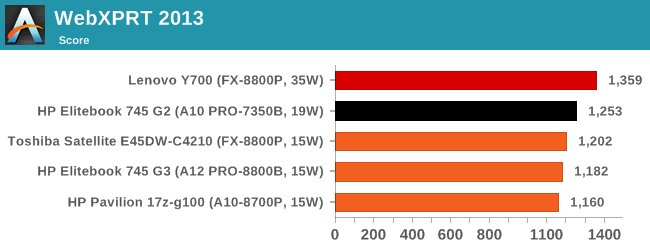
In both versions of the benchmark, the Kaveri system beats all the 15W Carrizo platforms. It was inevitable that at some point during the benchmarking that those extra four watts of thermal headroom in the chip might allow the CPU to turbo for longer – as WebXPRT is by nature a bursty workload, if it can use this to its advantage then we’ll surely see a regression.
I want to pull out some power numbers a little early here to show what I mean. Here are the two Elitebooks in WebXPRT 2013, whose scores differ by 6%:
These power numbers were taken under the ‘all else equal rule’, so each screen was at the same brightness and almost zero applications requesting run time in the background. Here we see that the Carrizo system is drawing less power on average in idle and load (a common theme), but suffers from higher peak power draw and a much larger average-to-idle change in power (which can be overshadowed by onboard components coming out of sleep). It means we get the very uneasy metric of 1208.7 J of energy consumed for the Kaveri over idle and 1932.8 J of energy consumed for Carrizo, though it does depend on how much idle is truly idle across the whole SoC and platform.
This might be where the performance deficit lies though – in a Carrizo system that boasts lower power at idle and lower power draw on average, in a bursty workload environment it is actually wasting time and power to switch things on and off constantly.
Cinebench 15/11.5
Cinebench is a widely known benchmarking tool for measuring performance relative to MAXON's animation software Cinema 4D. Cinebench has been optimized over a decade and focuses on purely CPU horsepower, meaning if there is a discrepancy in pure throughput characteristics, Cinebench is likely to show that discrepancy. Arguably other software doesn't make use of all the tools available, so the real world relevance might purely be academic, but given our large database of data for Cinebench it seems difficult to ignore a small five minute test. We run the modern version 15 in this test, as well as the older 11.5 due to our back data.
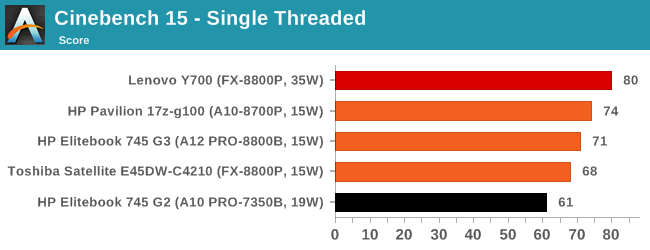

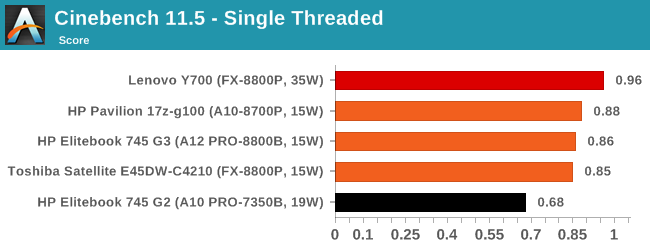
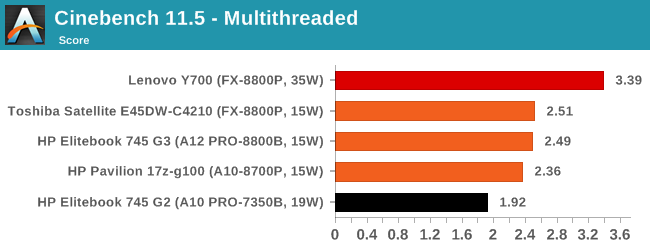
Cinebench shows the spread of performance relating to the microarchitecture advantages of Carrizo compared to Kaveri, as well as the benefits that a 35W part can give over a 15W part. That being said, this spread of results, while perhaps an academic answer to ‘which is the fastest’ is not often seen in the real world.
x264 HD 3.0
The x264 HD 3.0 package we use here is also kept for historic regressional data. The latest version is 5.0.1, and encodes a 1080p video clip into a high quality x264 file. Version 3.0 only performs the same test on a 720p file, and in most circumstances hits its limit on high end processors, but still works well for mainstream and low-end. Also, this version only takes a few minutes, whereas the latest can take over 90 minutes to run.
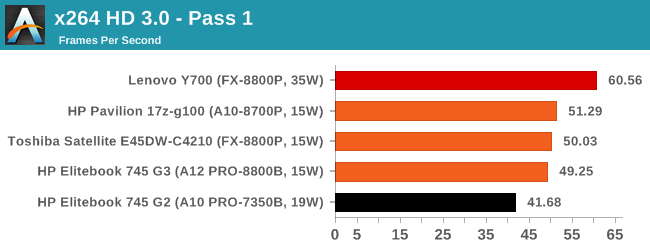
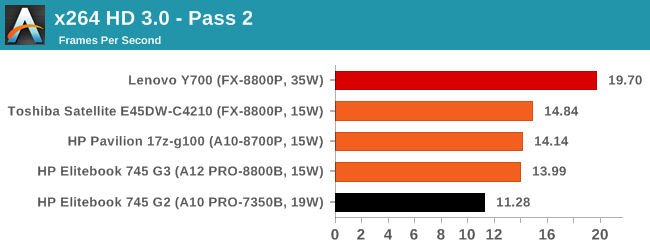
As with Cinebench, we get an ideal academic spread of data.






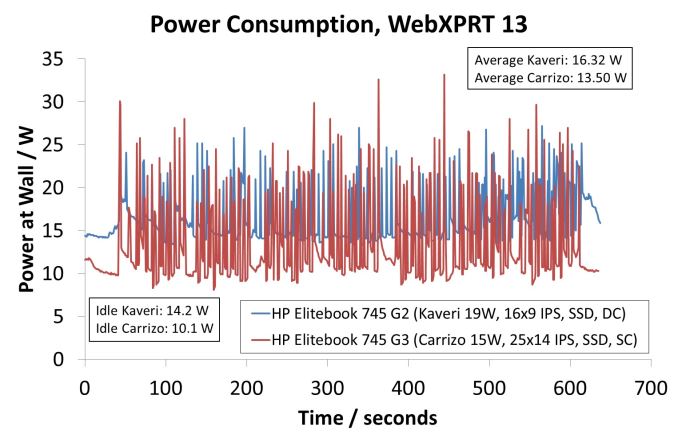








175 Comments
View All Comments
jakemonO - Wednesday, February 10, 2016 - link
no A12 core parts for the test? I can't find the A10 part on the HP websiote, only A8 & A12UtilityMax - Wednesday, February 10, 2016 - link
After a decade of hype since the ATI acquisition, nothing has changed. AMD has a massive OEM problem. Moreover, laptops have been outselling desktops for like a decade, yet AMD if you look at the history of AMD, it's hard to believe they ever really cared about portables. The Kaveri parts didn't even show up, while the Carrizo notebooks are already botched technology as explained in the article..gserli - Thursday, February 11, 2016 - link
I have to say that the $400 to $700 notebooks on sale are garbage.The IGPs are not strong enough for casual gaming like LOL and CS GO.
Crappy 5400RPM harddisk will make you want to throw the machine out of the window.
If you really need that little bit more performance.
Pay few hundred more. Or you can get a notebook that will hurt your arm if you carry it with one hand.
AMD needs to be more aggressive. Talk to the OEMs and give them better offer.
Convince them build a $700 notebook with 13 Inch 1080p IPS touch screen, 256GB SSD, 8GB RAM, A8 or A6 APU and below 1.5KG.
A lower end $600 one would work with 1366*768 IPS touch screen, 128GB SSD, 4GB RAM and A6 APU, below 1.5KG.
My $640 Asus TP300L is absolutely bullshit! I thought a mobile i5 would be enough for my daily use since I had a i5 desktop and was really satisfied with it.
CPU performance is not a issue nowadays. The IGP is slow, but I didn't expect it to be fast(Although the one on desktop is way more powerful).
The biggest problem is the GOD DAMN 5400RPM HARD DISK.
Not only did it affect the boot up speed. Every action I performed is awfully slow when there are some OS things running in background.
Only if I wait for 5 or 10 minutes after boot-up, then I can use it normally.
Please, kill all the 5400RPM Hard disk. They should not be in 2016.
farmergann - Thursday, February 11, 2016 - link
That's what I find so hilarious about all the Y700 6700hq lovers out there - all the CPU power in the world is relegated to potato status outside of b.s. benchmarks with that 5400rpm HDD. Save money with the FX8800p Y700 and buy an $80 250GB Samsung 850 Evo to slap in it...wow&wow - Thursday, February 11, 2016 - link
Will it be more appropriate to have "Additional" (Why not Update?) in the beginning, particularly the misleading pre-production stuff? Thanks for the article.farmergann - Thursday, February 11, 2016 - link
LOL, because the entire point of this article would be nullified. They didn't even bother comparing the FX8800p Y700 with the intels head to head outside of some DX9 garbage. Pitiful anandtech shills are pitiful. How many times did they mention Freesync? Yeah...silverblue - Friday, February 12, 2016 - link
To be fair, is there a point?xrror - Thursday, February 11, 2016 - link
"Some companies in the past have dealt with contra-revenue, selling processors at below cost or with deals on multiple parts when purchased together. Very few companies, typically ones with large market shares in other areas, have access to this. Some members of the industry also see it as not fighting fair, compared to actually just pricing the parts lower in the first place."I had to laugh so much as this. WHO COULD IT BE? MYSTERY!
It must be... Cyrix ! no? hrm. I give up. =P
dustwalker13 - Saturday, February 13, 2016 - link
still ... there is just no saving the bulldozer architecture, no matter how much they improve or iterate it.bulldozer and amd by proxy for normal users are synonyms for "just not as good as intel" and for a little more experienced users "that processor that cheated with its core count".
the few people who actually read articles like the one above and compare performance/value represent literally no market share.
the only way out for amd at this point is to create as much boom around their zen-cores as possible, get them out asap, hitch their little start to new buzzwords like hbm, old buzzwords like rage and hope they can actually deliver the performance figures needed in the first reviews to drive a wave of positive articles through the press. only then will they be able to get back into the market. i wish them the best, a surface 5 (non pro) with a low power zen apu on hbm sounds awsome ... i'd get one of those in a heartbeat.
yankeeDDL - Monday, February 15, 2016 - link
I own a Toshiba P50D-C-104. I read with interest this article and, albeit extremely helpful and rich of information, left some questions open, at least as far a I'm concerned.First of all, the P50D-C-104 costs <$600 and has an A10-8700P. I find this price range more relevant for home-users and, in general, for somebody interested in AMD offering.
1Kusd for a laptop with integrated GPU seems too expensive.
The P50D-C-104 has 2 DIMM slots; couldn't find for sure whether it is dual channel or not.
I am curios to know how it performs on some popular games against Intel's offering (at that price level, it would go against core i3, at best). In the page with comparison against Intel's offering there are almost only synthetic benchmarks: it would have been nice to compare on some actual games.
My point is that in the $1K range, there are many features that could add cost while not necessarily improving performance.